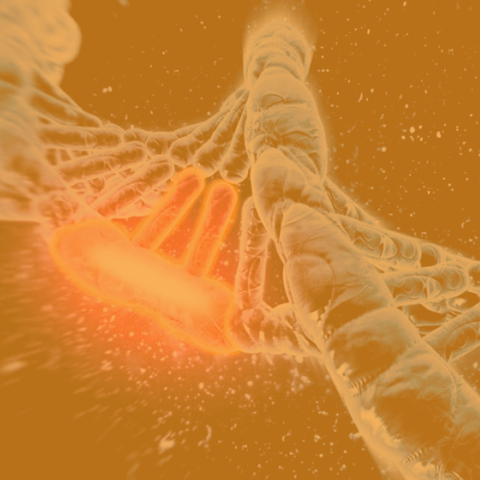
This fall, we will be releasing Tro+ Blue, our first product for practitioners only and not for general sale. Each Tro+ Blue troche will have 50 mg of USP methylene blue, and there will be 4 troches per pack.
We believe that everyone needs Tro+ Blue at the ready for acute inflammation, ischemia, infection, trauma, and when there is an immediate or significant need for mitochondrial support.
But before we dive into why (in significant detail), let’s rewind briefly to early 2020…
In February of 2020, Troscriptions launched Blue Cannatine. A few months later, at the request of Troscriptions users and clinicians on the front lines of the pandemic, we released Just Blue. Both products contained the powerful mitochondrial optimizer, methylene blue.
Prior to our launch, methylene blue was known only to a niche group of biohackers using lab-grade methylene blue (when they could get it) and a very small group of researchers studying it in a wide array of conditions including acute trauma, ischemia, models of dementia, infection, inflammation, and more.
Our task as a company was to translate this research, first to an early adopter audience, and then bring “the blue” to the masses.
From the beginning, we emphasized two important and very related points. The first was dosing. In the case of Just Blue, we chose a very low dose because of studies showing compelling benefits in patients with cognitive impairment, Alzheimer’s, and mental illness.
The second was the reason why it was helping at these low doses: methylene blue at very low doses was enhancing energy production, increasing detox capacity (increasing resilience), decreasing inflammation, and likely releasing various neurotransmitters that boosted energy, focus, mood, and cognition (norepinephrine, dopamine, serotonin, and acetylcholine).
Fast forward to the present day... where the popularity of methylene blue has exploded in our wake and the response to Just Blue has been overwhelming.
Users have reported a wide array of improvements, including decreased brain fog, better attention, more energy, less jet lag (see jet lag protocol here), less inflammation, more resilience to life’s stressors, more endurance, recovery from illnesses that didn’t respond to other treatments, fewer headaches, less joint pain, and the list goes on.
Tro+ Blue: Higher Dose Methylene Blue
While we still feel strongly that 16 mg of methylene blue is a great choice for regular use to holistically facilitate mitochondrial recovery and optimization, for years we have had requests from clinicians for a higher-strength product made to our quality standards (“Beyond USP” and GMP, which we’ll discuss in more detail later).
And for good reason(s)! There is a great deal of research showing that methylene blue at higher doses can be beneficial for infection (viral, fungal, bacterial, biofilms, etc.), inflammation, ischemia, and give a greater burst in both energy production and antioxidant capacity.
After a deep synthesis of the research and many conversations with clinicians around the world using methylene blue in practice (some of whom were using Just Blue by the pack to keep patients out of the hospital during the pandemic) for these indications, we found that the optimal dosing range of methylene blue is at its widest 0.5 to 3 mg/kg but very likely more optimal between 0.5 to 1.5 mg/kg.
This is why we decided to create Tro+ Blue with 50 mg troches for professional use only.
Methylene Blue, a Review of Mitochondrial Mechanisms
There are trillions of mitochondria in our body, most highly concentrated in the cells of our brain, liver, heart, ovaries, and muscle tissue [1]. Secondary to their high metabolic demands, these are the tissues where we most often see both acute and chronic mitochondrial dysfunction manifest.
As a quick review, mitochondria make ATP, our cellular currency, primarily via the electron transport chain (ETC) with its 5 complexes (complex I, II, III, IV, and V). Electrons from our food are donated to the ETC at complex I or complex II. These electrons are then shuttled through to complex IV. This shuttling powers complexes I, III, and IV to pump hydrogen ions from the inner to the outer mitochondrial membrane. At complex IV, oxygen is the final electron acceptor, and at complex V, also known as ATP synthase, hydrogen ions then move back into the inner mitochondrial space, creating ATP as they do so.

On the ETC, methylene blue is an electron cycler (i.e., can oxidize/take or reduce/donate electrons) [2]. Under normal conditions, methylene blue donates electrons to complex IV (cytochrome oxidase), enhancing ATP production. It also recycles NADH to NAD+, increasing the NAD+ pool [3]. This increased NAD+ pool drives more energy production and induces sirtuin activation.
In addition, when there are blocks in the ETC (i.e., dysfunctional complexes), methylene blue can bypass them and both maintain and enhance ATP production. The most common blocks are at complex I or complex II, both of which methylene blue can bypass by directly donating electrons to complex IV [4], as seen in the figure below.

If there is damage to complexes III, IV, or even V/ATP synthase, the mitochondria can still make energy through alternative mechanisms if methylene blue is available [5,6].
In addition, because methylene blue is an electron cycler, it also acts as a potent antioxidant [7], scavenging for/accepting free electrons (i.e., free radicals) in the mitochondria and cytosol, thereby decreasing inflammation and cellular stress (see below for more on this).
In short, methylene blue can make up for and neutralize damage on the ETC and, although a lower dose can support function in all these ways described above, there is a great deal of evidence that higher strength methylene blue in acute or more severe chronic situations of mitochondrial stress can rescue ATP generation and neutralize greater amounts of oxidative stress, saving mitochondria as well as the cells they live in.
Methylene Blue in Acute Inflammation and Pain
Methylene blue at doses of 1 to 3 mg/kg inhibits inducible or free-floating nitric oxide synthase that occurs due to stress [8]. This can be stress related to trauma, ischemia, toxicity, infection, or just about any etiology that causes acute inflammation. Note that our basal supply of nitric oxide synthase is located in cell membranes and thus protected from methylene blue. However, stress can cause nitric oxide synthase to be “free-floating” and increase NO production, one of the major pro-inflammatory mediators of a stress response.
Methylene blue easily neutralizes the NO produced via nitric oxide synthase by reducing it to NO2, an inert gas. This methylene blue effect has also been shown to decrease pain in experimental models [9].
Methylene blue at doses of 0.5 to 3 mg/kg can also downregulate the production of inflammatory cytokines [9], including IL6 and STAT3, as well as inflammasome activation[10].
In addition, inflammation also induces mitochondrial dysfunction [11] and methylene blue at doses of 0.5 to 3 mg/kg is again able to come to the rescue by bypassing dysfunctional complexes and maintaining ATP production as described above.
Finally, methylene blue also decreases inflammation by inducing a robust antioxidant response, especially via the NRF2 pathway and glutathione production (see below) [12].
Methylene Blue as an Antioxidant Booster
Methylene blue creates a powerful antioxidant capacity in two ways: scavenging/reducing free electrons and stimulating the body’s antioxidant response system.
Methylene blue scavenges free electrons in the mitochondria and cytosol, reducing (i.e., neutralizing) them and, in several studies, methylene blue is as or more powerful than NAC, MitoQ, and Vitamin A at doses between 50 to 100 mg [7].
Methylene blue at these same doses also upregulates the NRF2 pathway via H2O2 production [7]. Methylene blue makes H2O2 by taking a hydrogen molecule off NADH (oxidizing it), recycling it to NAD+, and then donating the H+ to oxygen (reducing it). It can also do this via the pentose-phosphate pathway.
This leads to a dramatic increase in antioxidant defenses and glutathione production [13].
Methylene Blue Mitigates Ischemia
Methylene blue has been well studied in various models of stroke [14], traumatic brain injury [15], methemoglobinemia (where it is still used in hospitals) [16], and other ischemic insults using doses of 0.5 to 3 mg/kg with significant benefits.
In stroke models, methylene blue improves cerebral blood flow while decreasing mitochondrial destruction, infarct size, and reperfusion injury. There is even a study using methylene blue and supplemental oxygen that improved recovery even more than methylene blue alone in animal models [17].
The mechanisms at play here are very likely related to methylene blue’s capacity to rescue mitochondrial ATP generation, decrease inflammation and pain, upregulate antioxidant capacity, and modulate mTor [14].
Although there have been very few studies done in humans (due to methylene blue being off-patent for decades), there is very likely a role for methylene blue as an abortive at the first signs of an ischemic episode (stroke, especially) alongside treatments that are well-known to improve outcomes, like antiplatelet therapy.
Methylene Blue is a Powerful Anti-Infective
Methylene blue was the first FDA-approved drug to treat Malaria in 1897 [18]. Prior to the development of antimicrobials in the 1950s, it was used for a host of bacterial, fungal, protozoal, and viral infections. It was especially useful for urinary tract infections, as methylene blue concentrates in the urine (and turns urine blue) [19]. The dose ranged from 0.5 mg/kg to as high as 12 mg/kg, the latter for Malaria treatment.
Methylene blue works as an antimicrobial via the production of hydrogen peroxide [6]. As mentioned, methylene blue takes a hydrogen molecule off NADH (oxidizing it), recycles NAD+, and donates the H+ to oxygen (reducing it) to make H2O2. It can also make H2O2 via the pentose phosphate pathway.
No matter how it is made, H2O2 kills organisms directly, especially enveloped viruses such as COVID [20] and Zika [21], parasites like Malaria, and cell-wall-containing bacteria such as staph [22], strep [23], enterococcus [24], E. coli plus other gram-negative bacterium [25], and many others that do not have inherent protection.
As described in several of the studies cited above for various microorganisms, methylene blue does this even more effectively with photodynamic therapy using wavelengths between 600 to 680 nm [25]. Light in this spectrum reacts with H2O2, creating singlet oxygen radicals which are highly reactive and can kill microorganisms more easily.
Methylene blue is also immunomodulatory due to H2O2 production [26], modulating immune system function by enhancing the activity of macrophages and neutrophils. Additionally, it can reduce excessive inflammation via the mechanisms above (stress-induced nitric oxide synthase production, cytokine downregulation, antioxidant production, etc.) to prevent tissue damage caused by an overactive immune response.
Methylene Blue as Biofilm Buster
A biofilm is a complex and organized community of microorganisms, primarily bacteria, that adhere to surfaces and are encased in a self-produced matrix of extracellular polymeric substances or EPS. This matrix is composed of various molecules such as polysaccharides, proteins, DNA, and other organic and inorganic materials. Biofilms can form on a wide range of surfaces, including medical devices, natural and industrial surfaces, pipes, and living tissues like the GI tract and teeth.
Biofilms, by and large, contribute to the health of organisms, however, there are many pathogens that create biofilms which make them very hard to eradicate such as Bartonella (see below).
Through H2O2 production, and at doses between 0.5 to 3 mg/kg, methylene blue works in several ways:
- Methylene blue disrupts the extracellular matrix, a key component of biofilms, which provides structural support and protection to the microorganisms within. By weakening the biofilm structure, methylene blue makes it more susceptible to eradication. This is why methylene blue is often used in combination with antimicrobial agents for a one-two punch.
- Methylene blue interferes with the ability of microorganisms to adhere to surfaces and form biofilms. By preventing initial adhesion, it reduces biofilm formation and limits their growth.
- Methylene blue penetrates the biofilm and directly targets microorganisms, inhibiting growth and causing their death.
Tro+ Blue Dosing and Examples
As mentioned above, the likely optimal range of methylene blue for acute inflammation, ischemia, infection, trauma, and when there are immediate needs for mitochondrial support is 0.5 to 1.5 mg/kg.
For severe and acute needs, including as an abortive for ischemic episodes or infection, we suggest starting at 25 mg or even up to 200 mg depending on ideal body weight and overall health status (i.e., the baseline level of mitochondrial stress or dysfunction, if known), but only using this dosing for a short period of time (see below for potential risks).
A common dosing strategy for a chronic condition that require significant support such as Chronic Fatigue Syndrome (Myalgic Encephalitis), Chronic Lyme, Mold, severe post COVID symptoms, Chronic viral infection (EBV, HSV), and others is to start at 25mg QOD (every other day) for the first week, then increasing to daily the second week, titrating up weekly from there to a max dose of up to 200mg per day. However, for most, the dose will 25 to 50mg per day.
If, however, the patient will likely be very sensitive, we suggest starting them at the lower dosing found in Just Blue (sometimes even as low as 1/4 troche = 4mg) and titrating up from there, potentially up to the the Tro+ Blue dosing strategy above if tolerated.
In addition, although methylene blue on its own is a powerful compound, it will often work best in conjunction with either standard of care or alternative therapeutics.
In Bartonella, for example, methylene blue is often used at doses between 25 to 100 mg daily in divided dose as a biofilm buster while other herbals or antimicrobials target Bartonella itself. This is also the case for interstitial cystitis where methylene blue is typically used as a biofilm buster while other therapeutics target insidious infections that are often part of the bladder ecosystem.
Photodynamic therapy combined with Tro+ Blue also has considerable potential as an anti-infective at doses typically between 25 to 50 mg twice daily.
As always, our buccal troches are scored into quarters for a calibrated dose delivery. However, due to the amount of methylene blue in each Tro+ Blue troche and methylene blue’s high bioavailability, it is best swallowed rather than used as a troche.
Precautions of Higher Dose Methylene Blue
Methylene blue, especially at higher doses (>1/kg), prevents the reuptake of serotonin by nerve cells in the brain and will increase serotonin levels via significant MAOI inhibition. While this mechanism can be beneficial, it also poses a risk of serotonin syndrome when used in combination with other medications that increase serotonin levels such as SSRIs, SNRIs, and other medications that block serotonin reuptake. Please use caution when combining methylene blue with serotonin reuptake inhibitors although the risk for an interaction is low, even at Tro+ Blue dosing is low. All serotonin syndrome cases reported have been due to the use of IV methylene blue which increases CNS concentrations very quickly + high dose SSRIs. There have been no reports of serotonin syndrome from oral methylene blue [27].
Methylene blue at high doses may also induce hemolysis in individuals with G6PD deficiency. G6PD deficiency is a genetic disorder that affects red blood cells. It is caused by a deficiency of an enzyme called glucose-6-phosphate dehydrogenase, which plays a crucial role in protecting red blood cells from damage caused by certain substances. Individuals with G6PD deficiency have red blood cells that are more susceptible to damage when exposed to certain triggers, such as high amounts of oxidative stress. This has only been reported at high doses of methylene blue (>3 mg/kg) and typically in very sick patients (i.e hospitalized patients) but caution is still advised [28].
In addition, methylene blue at high doses, taken for long periods of time, can also potentially cause gastric ulcerations, disrupt normal biofilms, and even cause oxidative overload. See this blog article for more information on these risks.
For all of the above reasons, we highly recommend only short courses of Tro+ Blue or, if longer courses are needed, intermittent dosing (if possible) and close monitoring.
A note on Just Blue and H2O2:
Just Blue contains 16 mg of methylene blue, which very likely makes very little H2O2, if any, although there are no specific studies to show this (yet). At these low doses, there isn’t enough methylene blue to compete with oxygen’s binding site on complex IV (i.e., compete with oxygen’s role as an electron sink/final electron acceptor on the ETC).
However, when the dose of methylene blue is higher (starting at 0.5 mg/kg and increasing significantly after 1 mg/kg), there is more methylene blue to bind oxygen before it gets to complex IV and thus reduce oxygen to H2O2 prior to oxygen reaching its binding site.
BEYOND USP
Another special precaution: All methylene blue is NOT the same. And this is just a quick reminder.
Industrial and chemical grade methylene blue can consist of up to 11% of impurities, which can include heavy metals like arsenic, cadmium, and lead [2].
Your safest choice is USP (pharmaceutical grade) methylene blue, but even USP can have impurities. This is why it’s important to not only ensure your methylene blue is USP but also that it has testing that documents its purity and potency.
At Troscriptions, our methylene blue is third-party tested by our manufacturer to ensure purity/potency, it is USP grade, and is independently tested again by another lab for purity/potency with each troche batch we make. This is why we call our methylene blue Beyond USP. There are very few, if any, other companies out there with as rigorous a process as ours to ensure the highest quality possible.
Conclusion
Methylene blue has amazing versatility across the spectrum of health and disease.
Just Blue was created to gently lift up mitochondrial energy and detox capacity. And, as described in the introduction, it does this with precision and with wide-ranging benefits.
Tro+ Blue is different. It was developed for acute inflammation, ischemia, trauma, infections, and when there is an immediate or significant need for mitochondrial support. In short, it was developed for urgent and emergent situations.
Give your patients a supply so they have it on hand and at the ready, and keep some at home for you and your loved ones too.
References
- MitoCanada. What are mitochondria and why they matter; 2022. https://mitocanada.org/understanding-mito/what-are-mitochondria/
- Rojas JC, Burchey AK, Gonzalez-Lima F. Neurometabolic mechanisms for memory enhancement and neuroprotection of methylene blue. Prog. Neurobiol. 2011;96(1):32-45. doi: 10.1016/j.pneurobio.2011.10.007
- Atamna H, Atamna W, Al-Eyd G, Shanower G, Dhahbi JM. Combined activation of the energy and cellular-defense pathways mat explain the potent anti-senescence activity of methylene blue. Redox Biology. 2015;6:426-435. doi: 10.1016/j.redox.2015.09.004
- Yang L, Youngblood H, Wu C, Zhang Q. Mitochondria as a target for neuroprotection: role of methylene blue and photobiomodulation. Translational Neurodegeneration. 2020;9(19). doi: 10.1186/s40035-020-00197-z
- Haouzi P, Tubbs N, Cheung J, Judenherc-Haouzi A. Methylene Blue Administration During and After Life-Threatening Intoxication by Hydrogen Sulfide: Efficacy Studies in Adult Sheep and Mechanisms of Action. Toxicol. Sci. 2019;168(2):4430459. doi: 10.1093/toxsci/kfy308
- Tretter L, Horvath G, Holgyesi A, Essek F, Adam-Vizi V. Enhanced hydrogen peroxide generation accompanies the beneficial bioenergetic effects of methylene blue in isolated brain mitochondria. Free Radical Biology and Medicine. 2014;77:317-330. doi: 10.1016/j.freeradbiomed.2014.09.024
- Xiong Z, O’Donovan M, Sun L, Choi J, Ren M, Cao K. Anti-Aging Potentials of Methylene Blue for Human Skin Longevity. Sci. Rep. 2017;7:2475. doi: 10.1038/s41598-017-02419-3
- Lomniczi A, Cebral E, Canteros G, McCann SM, Rettori V. Methylene blue inhibits the increase of inducible nitric oxide synthase activity induced by stress and lipopolysaccharide in the medial basal hypothalamus of rats. Neuroimmunomodulation. 2000;8(3):122-127. doi: 10.1159/000054271
- Lee SW, Han HC. Methylene Blue Application to Lessen Pain: Its Analgesic Effect and Mechanism. Frontiers in Neuroscience. 2021;15:663650. doi: 10.3389/fnins.2021.663650
- Lin ZH, Wang SY, Chen LL, Zhuang JY, Ke QF, Xiao DR, Lin WP. Methylene Blue Mitigates Acute Neuroinflammation after Spinal Cord Injury through Inhibiting NLRP3 Inflammasome Activation in Microglia. Front Cell Neurosci. 2017;11:391. doi: 10.3389/fncel.2017.00391
- Missiroli S, Genovese I, Perrone M, Vezzani B, Vitto VAM, Giorgi C. The Role of Mitochondria in Inflammation: From Cancer to Neurodegenerative Disorders. Journal of Clinical Medicine. 2020;9(3):740. doi: 10.3390/jcm9030740
- Bhurtel S, Bok E, Katila N, Kim J, Choi DY. Activation of Nrf2 by methylene blue is associated with the neuroprotection against MPP+ induced toxicity via ameliorating oxidative stress and mitochondrial dysfunction. Biochem Pharmacol. 2021;192:114719. doi: 10.1016/j.bcp.2021.114719
- Kelner MJ, Alexander NM. Methylene blue directly oxidizes glutathione without the intermediate formation of hydrogen peroxide. Journal of Biological Chemistry. 1985;260(28):15168-15171. doi: 10.1016/S0021-9258(18)95717-0
- Jiang Z, Duong TQ. Methylene blue treatment in experimental ischemic stroke: A mini-review. Brain Circulation. 2016;2(1):48-53. doi: 10.4103/2394-8108.178548
- Watts LT, Long JA, Chemello J, Koughnet SV, Fernandez A, Huang S, Shen Q, Duong TQ. Methylene Blue Is Neuroprotective against Mild Traumatic Brain Injury. Journal of Neurotrauma. 2014;31(11):1063-1071. doi: 10.1089/neu.2013.3193
- Farkas J. Methemoglobinemia; 2021. https://emcrit.org/ibcc/methemoglobinemia/
- Rodriguez P, Zhao J, Milman B, Tiwari YV, Duong TQ. Methylene blue and normobaric hyperoxia combination therapy in experimental ischemic stroke. Brain and Behavior. 2016;6(7):e00478. doi: 10.1002/brb3.478
- Calderón M, Weitzel T, Rodriguez MF, Ciapponi A. Methylene blue for treating malaria. The Cochrane Database of Systematic Reviews. 2017;2017(10):CD012837. doi: 10.1002/14651858.CD012837
- Gama CRB, Pombo MAG, Nunes CP, Gama GF, Mezitis SGE, Neto MS, Guimarães OR, Geller M, Oliveira L, Sitnoveter A, Goldwasser G, Cunha KS, Darrigo Junior LG. Treatment of Recurrent Urinary Tract Infection Symptoms with Urinary Antiseptics Containing Methenamine and Methylene Blue: Analysis of Etiology and Treatment Outcomes. Research and Reports in Urology. 2020;12:639-649. doi: 10.2147/RRU.S279060
- Bose P. Study finds methylene blue is a low-micromolar inhibitor of the the SARS-CoV-2 spike protein and ACE2 interaction; 2022. https://www.news-medical.net/news/20220325/Study-finds-methylene-blue-is-a-low-micromolar-inhibitor-of-the-the-SARS-CoV-2-spike-protein-and-ACE2-interaction.aspx
- Li Z, Lang Y, Sakamuru S, Samrat S, Trudeau N, Kuo L, Rugenstein N, Tharappel A, Koetzner CA, Hu S, Zhang J, Huang R, Kramer LD, Butler D, Xia M, Li H. Methylene blue is a potent and broad-spectrum inhibitor against Zika virus in vitro and in vivo. Emerging Microbes & Infections. 2020;9(1):2404-2416. doi: 10.1080/22221751.2020.1838954
- Sauer K, Steczko J, Ash SR. Effect of a solution containing citrate/Methylene Blue/parabens on Staphylococcus aureus bacteria and biofilm, and comparison with various heparin solutions. Journal of Antimicrobial Chemotherapy. 2009;63(5):937-945. doi: 10.1093/jac/dkp060
- Kassab A, Dabous O, Morsy M. A novel management of streptococcal pharyngotonsillar infections by laser-activated silver nanoparticles and methylene blue conjugate, in vitro study. International Journal of Pediatric Otorhinolaryngology. 2017;100:114-118. doi: 10.1016/j.ijporl.2017.06.005
- Maliszewska I, Wróbel J, Wanarska E, Podhorodecki A, Matczyszyn K. Synergistic effect of methylene blue and biogenic gold nanoparticles against Enterococcus faecalis. Photodiagnosis and Photodynamic Therapy. 2019;27:218-226. doi: 10.1016/j.pdpdt.2019.05.042
- Songsantiphap C, Vanichanan J, Chatsuwan T, Asawanonda P, Boontaveeyuwat E. Methylene Blue–Mediated Antimicrobial Photodynamic Therapy Against Clinical Isolates of Extensively Drug Resistant Gram-Negative Bacteria Causing Nosocomial Infections in Thailand, An In Vitro Study. Frontiers in Cellular and Infection Microbiology. 2022;12:929242. doi: 10.3389/fcimb.2022.929242
- Li Y, Ying W. Methylene blue reduces the serum levels of interleukin-6 and inhibits STAT3 activation in the brain and the skin of lipopolysaccharide-administered mice. Frontiers in Immunology. 2023;14:1181932. doi: 10.3389/fimmu.2023.1181932
- Gillman PK. CNS toxicity involving methylene blue: the exemplar for understanding and predicting drug interactions that precipitate serotonin toxicity. Journal of Psychopharmacology. 2011;25(3):429-436. doi:10.1177/0269881109359098
- Balwani MR, Bawankule CP, Ramteke V, Tolani P, Vakil S, Yadav R. Methylene Blue Induced Methemoglobinemia with Acute Kidney Injury in a Glucose-6-Phosphate Dehydrogenase-deficient Patient. Indian J Nephrol. 2017 Nov-Dec;27(6):465-467. doi: 10.4103/ijn.IJN_316_16. PMID: 29217886; PMCID: PMC5704414






Comments (0)
There are no comments for this article. Be the first one to leave a message!